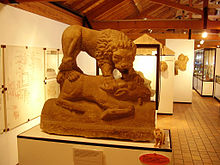- Corbridge Lion
-
The Corbridge Lion, Northumberland, England, is an ancient Roman free-standing sandstone sculpture of a male lion standing on a prone animal (possibly a deer) on a semi-cylindrical coping stone base. Measuring 0.95m in length by 0.36m in width and 0.87m high, it was originally a piece of decorative funerary ornamentation from a tomb (symbolising the conquest of Death over Life). It was subsequently re-used as a fountainhead by passing a water pipe through its mouth. It was found in a water tank in 1907 in excavations led by Leonard Woolley on Site II (a corridor building with tesselated floors, hypocausts, and painted wallplaster that has been suggested as a mansio or posting station) on the Roman site at Corbridge. It is believed to date to the 2nd or 3rd centuries AD.[1]
In his autobiographical volume Spadework, Woolley noted that it was found whilst he was at the bank in Corbridge collecting the workers' wages, and that when they revealed their discovery to him upon his return, the man who excavated it commented "when I first saw that there lion he had a blooming orange in 'is mouth!" (Woolley 1953:16).
At least four other stone lions have been found at Corbridge, two of them excavated in association with the enclosure wall around a 2nd-century mausoleum at Shorden Brae, in the cemetery just west of the Roman town (Gillam and Daniels 1961), one built into a wall in the village (Phillips 1977:32), and another (now lost) was in the private museum owned by Bartholomew Lumley during the early 19th century (Dickinson 2000:114).
The Corbridge Lion is now on display in the Corbridge Roman site museum run by English Heritage. The Lion of Corbridge Hotel (closed 2003), immediately south of the modern bridge, was named after it.
References
- ^ Phillips 1977:31
- Dickinson, G. (2000) Corbridge – the Last Two Thousand Years (London)
- Gillam, J.P. and Daniels, C.M. (1961) "The Roman mausoleum on Shorden Brae, Beaufront, Corbridge, Northumberland", Archaeologia Aeliana (4th Series) 39, 37–62
- Phillips, E.J. (1977) Corpus Signorum Imperium Romani I,i Corbridge, Hadrian's Wall East of the North Tyne (Oxford), 31–2, No. 82, Plate 24
- Woolley, L. (1953) Spadework: Adventures in Archaeology (London)
External links
Categories:- Roman Empire sculptures
- History of Northumberland
- Archaeological sites in Northumberland
- Roman Britain
- Hadrian's Wall
- Lions in art
Wikimedia Foundation. 2010.

